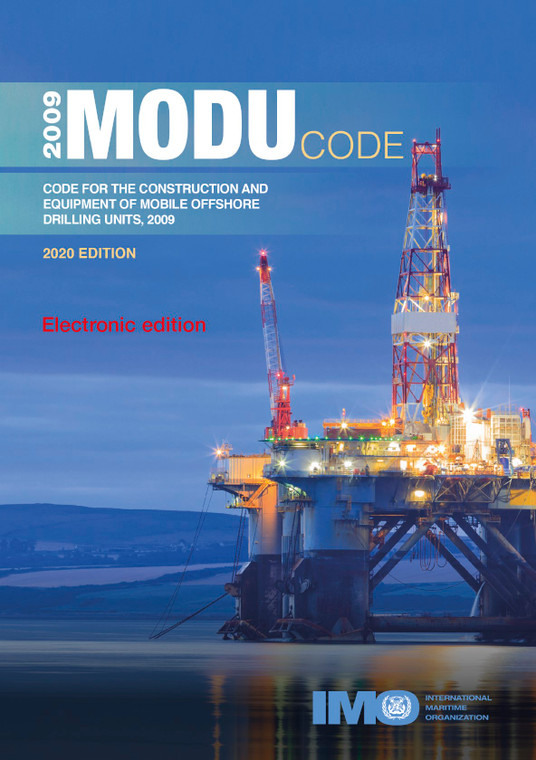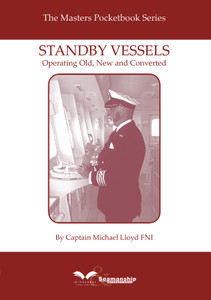
This publication provides an international standard for mobile offshore drilling units (MODUs) constructed on or after 1st January 2012. It facilitates their international movement and operation and ensures a level of safety for such units and for personnel on board, equivalent to that required by the 1974 SOLAS Convention and the Protocol of 1988 relating to the International Convention on Load Lines, 1966, for conventional ships engaged on international voyages.
This edition of the 2009 MODU Code incorporates the 2013 (MSC.359(92)), 2014 (MSC.384(94) and MSC.387(94)), 2016 (MSC.407(96)) and 2017 (MSC.435(98)) amendments to the Code. For mobile offshore drilling units constructed before 1 January 2012, the provisions of the previous MODU Codes (1989 and 1979) apply, depending on the date of their construction.
In adopting the 2009 MODU Code, the Assembly recalled in particular that, since the adoption of the 1989 MODU Code, the Organization had adopted a significant number of amendments to many of the regulations of the International Convention for the Safety of Life at Sea, 1974 (SOLAS) referenced in the Code. Furthermore, the International Civil Aviation Organization (ICAO) had adopted amendments to the Convention on International Civil Aviation, which impacted on the provisions for helicopter facilities as contained in the Code.
The 2009 MODU Code provides an international standard for MODUs of new construction, which facilitates their international movement and operation and ensures a level of safety for such units and for personnel on board, equivalent to that required by the 1974 SOLAS Convention and the Protocol of 1988 relating to the International Convention on Load Lines, 1966, for conventional ships engaged on international voyages.
The 2009 MODU Code supersedes the 1989 MODU Code, adopted by resolution A.649(16), for mobile offshore drilling units, the keels of which were laid or which were at a similar stage of construction on or after 1st January 2012.
This edition incorporates the 2013 (MSC.359(92)), 2014 (MSC.384(94)) and MSC.387(94)), 2016 (MSC.407(96)) and 2017 (MSC.435(98)) amendments to the Code.
For mobile offshore drilling units constructed before 1 January 2012, the provisions of the previous MODU Codes (1989* and 1979†) apply, depending on the date of their construction.
Chapter 1 General .
1.1 Purpose
1.2 Application
1.3 Definitions
1.4 Exemptions
1.5 Equivalents
1.6 Surveys and certification
1.7 Control
1.8 Casualties
1.9 Review of the Code
Chapter 2 Construction, strength and materials
2.1 General
2.2 Access
2.3 Design loads
2.4 Structural analysis
2.5 Special considerations for surface units
2.6 Special considerations for self-elevating units
2.7 Special considerations for column-stabilized units
2.8 Towing arrangements
2.9 Fatigue analysis
2.10 Materials
2.11 Anti-fouling systems
2.12 Protective coatings of dedicated seawater ballast tanks
2.13 Construction portfolio
2.14 Welding
2.11 Anti-fouling systems
2.12 Protective coatings of dedicated seawater ballast tanks
2.13 Construction portfolio
2.14 Welding
2.15 Testing
2.16 Drainage and sediment control
Chapter 3 Subdivision, stability and freeboard
3.1 Inclining test
3.2 Righting moment and heeling moment curves
3.3 Intact stability criteria
3.4 Subdivision and damage stability
3.5 Extent of damage
3.6 Watertight integrity
3.7 Freeboard
Chapter 4 Machinery installations for all types of units
4.1 General
4.2 Alternative design and arrangements
4.3 Machinery
4.4 Steam boilers and boiler feed systems
4.5 Steam pipe systems
4.6 Machinery controls
4.7 Air pressure systems
4.8 Arrangements for oil fuel, lubricating oil and other flammable oils
4.9 Bilge pumping arrangements
4.10 Ballast pumping arrangements on column-stabilized units.
4.11 Protection against flooding
4.12 Anchoring arrangements for surface and column-stabilized units
4.13 Dynamic positioning systems
4.14 Elevating systems for self-elevating units
Chapter 5 Electrical installations for all types of units
5.1 General
5.2 Alternative design and arrangements
5.3 Main source of electrical power
5.4 Emergency source of electrical power
5.5 Starting arrangements for emergency generators
5.6 Precautions against shock, fire and other hazards of electrical origin
5.7 Alarms and internal communication
Chapter 6 Machinery and electrical installations in hazardous areas for all types of units
6.1 Zones
6.2 Classification of hazardous areas
6.3 Openings, access and ventilation conditions affecting the extent of hazardous areas
6.4 Ventilation of hazardous spaces
6.5 Emergency conditions due to drilling operations
6.6 Electrical installations in hazardous areas
6.7 Machinery installations in hazardous areas
Chapter 7 Machinery and electrical installations for self-propelled units
7.1 General
7.2 Means of going astern
7.3 Steam boilers and boiler feed systems
7.4 Machinery controls
7.5 Steering
7.6 Electric and electrohydraulic steering gear
7.7 Communication between the navigating bridge and the engine-room
7.8 Engineers’ alarm
7.9 Main source of electrical power
7.10 Emergency source of electrical power
Chapter 8 Periodically unattended machinery spaces
for all types of units
8.1 General
8.2 Application
8.3 Fire protection
8.4 Protection against flooding
8.5 Bridge control of propulsion machinery
8.6 Communication
8.7 Alarm system
8.8 Special provisions for machinery, boiler and electrical installations
8.9 Safety systems
Chapter 9 Fire safety
9.1 Alternative design and arrangements
9.2 Structural fire protection
9.3 Protection of accommodation spaces, service spaces and control stations
9.4 Means of escape
9.5 Fire safety systems
9.6 Emergency escape breathing devices
9.7 Fire pumps, fire mains, hydrants and hoses
9.8 Fire-extinguishing arrangements for the drill floor
9.9 Fire-extinguishing arrangements in machinery spaces and in spaces containing fired processes
9.10 Portable fire extinguishers in accommodation, service and working spaces
9.11 Fire detection and alarm system
9.12 Flammable gas detection and alarm system
9.13 Hydrogen sulphide detection and alarm system
9.14 Fire-fighters’ outfits
9.15 Recharging of air cylinders
9.16 Arrangements in machinery and working spaces
9.17 Provisions for helicopter facilities
9.18 Storage of gas cylinders
9.19 Fire control plan
9.20 Operational readiness and maintenance
Chapter 10 Life-saving appliances and equipment
10.1 General
10.2 Alternative design and arrangements
10.3 Survival craft
10.4 Survival craft muster and embarkation arrangements
10.5 Survival craft launching stations
10.6 Stowage of survival craf
10.7 Survival craft launching and recovery arrangements
10.8 Rescue boats
10.9 Stowage of rescue boats
10.10 Rescue boat embarkation, launching and recovery arrangements
10.11 Lifejackets
10.12 Immersion suits and anti-exposure suits
10.13 Lifebuoys
10.14 Radio life-saving appliances
10.15 Distress flares
10.16 Line-throwing appliances
10.17 Operating instructions
10.18 Operational readiness, maintenance and inspections
Chapter 11 Radiocommunication and navigation
11.1 General
11.2 Training
11.3 Self-propelled units
11.4 Non-self-propelled units under tow
11.5 Units stationary at the site or engaged in drilling operation
11.6 Helicopter communications
11.7 Internal communications
11.8 Performance standards
11.9 Survey of the radio station
11.10 Navigation equipment
Chapter 12 Lifting devices, personnel and pilot transfer
12.1 Cranes
12.2 Lifting and hoisting equipment
12.3 Personnel lifts
12.4 Personnel and pilot transfer
12.5 Drilling derricks
Chapter 13 Helicopter facilities
13.1 General
13.2 Definitions
13.3 Construction
13.4 Arrangements
13.5 Visual aids
13.6 Motion-sensing system
13.7 Exemptions
Chapter 14 Operations
14.1 Operating manuals
14.2 Helicopter facilities
14.3 Material safety data sheets
14.4 Dangerous goods
14.5 Pollution prevention
14.6 Transfer of material, equipment or personnel
14.7 Procedures for entry into enclosed spaces
14.8 Diving systems
14.9 Safety of navigation
14.10 Emergency procedures
14.11 Emergency instructions
14.12 Training manual and onboard training aids
14.13 Practice musters and drill
14.14 Enclosed space entry and rescue drills
14.15 Onboard training and instructions
14.16 Records
14.17 Hazardous areas.
Chapter 15 Special measures to enhance safety
15.1 Atmosphere testing instrument for enclosed spaces
A??s a specialized agency of the United Nations, IMO is the global standard-setting authority for the safety, security and environmental performance of international shipping. Its main role is to create a regulatory framework for the shipping industry that is fair and effective, universally adopted and universally implemented.
In other words, its role is to create a level playing field so that ship operators cannot address their financial issues by simply cutting corners and compromising on safety, security and environmental performance. This approach also encourages innovation and efficiency.
Shipping is a truly international industry, and it can only operate effectively if the regulations and standards are themselves agreed, adopted and implemented on an international basis. IMO is the forum at which this process takes place.
- Number of Pages:
- 207
- ISBN:
- 9789280100549
- Published Date:
- May 2020
- Book Height:
- 250 mm
- Book Width:
- 210 mm
- Author:
International Maritime Organization
- Preview:
- Yes
- Publication Date:
- May 2020





